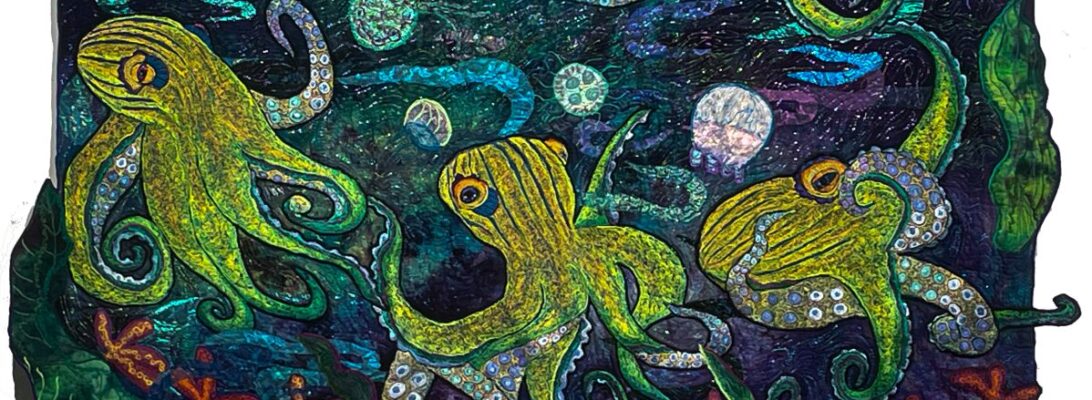
One of the issues with free motion embroidery is that it always puckers up. You always have some distortion. The worst is that the distortion is uneven and unpredictable. Sometimes it pulls the piece out of shape or makes it unrecognizable. Free motion objects take a lot of time. It’s heart breaking to have them distort past usability. It’s best to adjust for that from the start.
There’s some time honored ways to deal with distortion. First make the embroidery off the surface of the quilt. It can be applied afterwards with minimal distortion. I will be talking about separate embroideries in this article, although the information works for both off and on the quilt surface.
Stabilizers help a lot. Small embroideries under 2″ use three stabilizers all together. The drawing itself is on Totally Stable. It’s a lightweight stabilizer that irons on and is removeable. Stitch and Tear is the next layer. It’s a stiff tear away Pellon. Then I use a layer of acrylic felt that absorbs much of the stitching. I prefer the thinner versions. I attach the stitch and tear and felt with 505 spray. For anything larger, I use a layer of hand dyed fabric as the top layer.


Do remember that the drawing on the back will face the opposite side on the front. I know, I know. Think of it as looking through a slide backwards.
Now it gets confusing. My drawing layer is on the back. I’m going to turn it upside down to stitch. I’m not going to call them top and bottom. The sandwich has a front and the back. For stitching purposes the front is on the bottom and the back is on top. Got it?

I am using two hoops. Sharon Schamber’s red weighted halo hoop is my very favorite. It has a weighted core and a rubber coating. It grips and the weight supplies support.
Now it’s all up to the drawing. We can’t accurately predict the distortion but we can take some good guesses. To do that we need to look at the zigzag stitch

The zigzag stitch pulls across the stitch. The more layers of stitching, the more distortion. For a larger piece, you need to draw to adjust for that distortion. Mostly that means that things need to be a lot wider and bit longer. But you need to analyze the drawing to see where the distortion is likely to be bad.
So if you’re doing a straight zigzag stitch down the legs, it will shrink in the width. You’ll want to make it a bit wider there so it doesn’t become pencil thin.
Bird feathers end with a band of stitching around the end of the feather. Again, making the feathers longer and a bit too wide gives your a bit of extra space there will help eliminate the shrinkage effect.



I’ve elongated the wings and body on the kingfisher. I wasn’t able to get it completely embroidered to show you, but you can see the shrinking on the feather and the wings


It’s not a science. But you can hedge your bets for your best look. Keep watching my face book page to see how this bird looks finished.
What happens if you guess wrong? Several things. Sometimes that wrong guess works better than a correct guess. Sometimes I cut into an embroidery and anchor it with stitching to address the error. One thing is certain. Perfect happens somewhere else. I’m content with beautiful.


























































